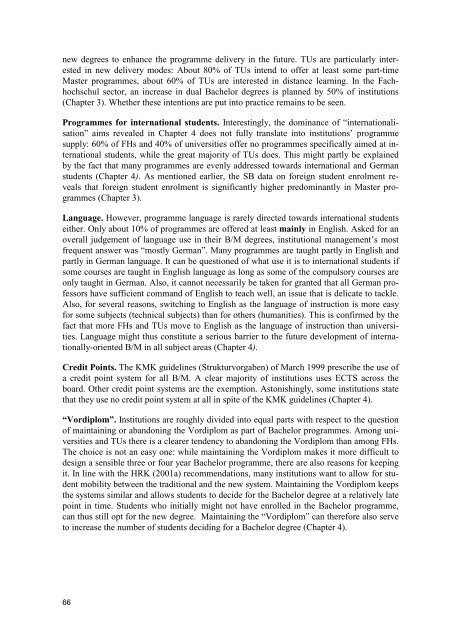and Master Programmes in German Higher Education Institutions
and Master Programmes in German Higher Education Institutions
and Master Programmes in German Higher Education Institutions
- No tags were found...
You also want an ePaper? Increase the reach of your titles
YUMPU automatically turns print PDFs into web optimized ePapers that Google loves.
new degrees to enhance the programme delivery <strong>in</strong> the future. TUs are particularly <strong>in</strong>terested<strong>in</strong> new delivery modes: About 80% of TUs <strong>in</strong>tend to offer at least some part-time<strong>Master</strong> programmes, about 60% of TUs are <strong>in</strong>terested <strong>in</strong> distance learn<strong>in</strong>g. In the Fachhochschulsector, an <strong>in</strong>crease <strong>in</strong> dual Bachelor degrees is planned by 50% of <strong>in</strong>stitutions(Chapter 3). Whether these <strong>in</strong>tentions are put <strong>in</strong>to practice rema<strong>in</strong>s to be seen.<strong>Programmes</strong> for <strong>in</strong>ternational students. Interest<strong>in</strong>gly, the dom<strong>in</strong>ance of “<strong>in</strong>ternationalisation”aims revealed <strong>in</strong> Chapter 4 does not fully translate <strong>in</strong>to <strong>in</strong>stitutions’ programmesupply: 60% of FHs <strong>and</strong> 40% of universities offer no programmes specifically aimed at <strong>in</strong>ternationalstudents, while the great majority of TUs does. This might partly be expla<strong>in</strong>edby the fact that many programmes are evenly addressed towards <strong>in</strong>ternational <strong>and</strong> <strong>German</strong>students (Chapter 4). As mentioned earlier, the SB data on foreign student enrolment revealsthat foreign student enrolment is significantly higher predom<strong>in</strong>antly <strong>in</strong> <strong>Master</strong> programmes(Chapter 3).Language. However, programme language is rarely directed towards <strong>in</strong>ternational studentseither. Only about 10% of programmes are offered at least ma<strong>in</strong>ly <strong>in</strong> English. Asked for anoverall judgement of language use <strong>in</strong> their B/M degrees, <strong>in</strong>stitutional management’s mostfrequent answer was “mostly <strong>German</strong>”. Many programmes are taught partly <strong>in</strong> English <strong>and</strong>partly <strong>in</strong> <strong>German</strong> language. It can be questioned of what use it is to <strong>in</strong>ternational students ifsome courses are taught <strong>in</strong> English language as long as some of the compulsory courses areonly taught <strong>in</strong> <strong>German</strong>. Also, it cannot necessarily be taken for granted that all <strong>German</strong> professorshave sufficient comm<strong>and</strong> of English to teach well, an issue that is delicate to tackle.Also, for several reasons, switch<strong>in</strong>g to English as the language of <strong>in</strong>struction is more easyfor some subjects (technical subjects) than for others (humanities). This is confirmed by thefact that more FHs <strong>and</strong> TUs move to English as the language of <strong>in</strong>struction than universities.Language might thus constitute a serious barrier to the future development of <strong>in</strong>ternationally-orientedB/M <strong>in</strong> all subject areas (Chapter 4).Credit Po<strong>in</strong>ts. The KMK guidel<strong>in</strong>es (Strukturvorgaben) of March 1999 prescribe the use ofa credit po<strong>in</strong>t system for all B/M. A clear majority of <strong>in</strong>stitutions uses ECTS across theboard. Other credit po<strong>in</strong>t systems are the exemption. Astonish<strong>in</strong>gly, some <strong>in</strong>stitutions statethat they use no credit po<strong>in</strong>t system at all <strong>in</strong> spite of the KMK guidel<strong>in</strong>es (Chapter 4).“Vordiplom”. <strong>Institutions</strong> are roughly divided <strong>in</strong>to equal parts with respect to the questionof ma<strong>in</strong>ta<strong>in</strong><strong>in</strong>g or ab<strong>and</strong>on<strong>in</strong>g the Vordiplom as part of Bachelor programmes. Among universities<strong>and</strong> TUs there is a clearer tendency to ab<strong>and</strong>on<strong>in</strong>g the Vordiplom than among FHs.The choice is not an easy one: while ma<strong>in</strong>ta<strong>in</strong><strong>in</strong>g the Vordiplom makes it more difficult todesign a sensible three or four year Bachelor programme, there are also reasons for keep<strong>in</strong>git. In l<strong>in</strong>e with the HRK (2001a) recommendations, many <strong>in</strong>stitutions want to allow for studentmobility between the traditional <strong>and</strong> the new system. Ma<strong>in</strong>ta<strong>in</strong><strong>in</strong>g the Vordiplom keepsthe systems similar <strong>and</strong> allows students to decide for the Bachelor degree at a relatively latepo<strong>in</strong>t <strong>in</strong> time. Students who <strong>in</strong>itially might not have enrolled <strong>in</strong> the Bachelor programme,can thus still opt for the new degree. Ma<strong>in</strong>ta<strong>in</strong><strong>in</strong>g the “Vordiplom” can therefore also serveto <strong>in</strong>crease the number of students decid<strong>in</strong>g for a Bachelor degree (Chapter 4).66
















